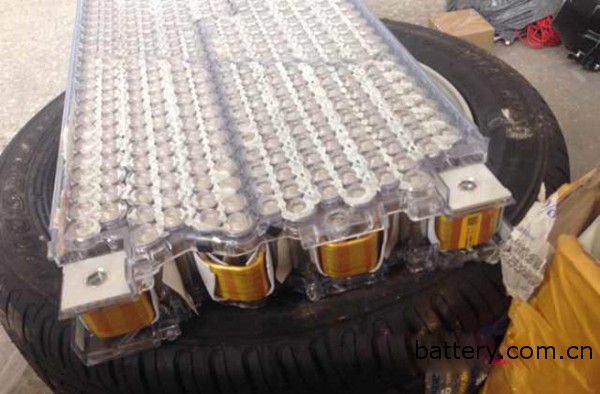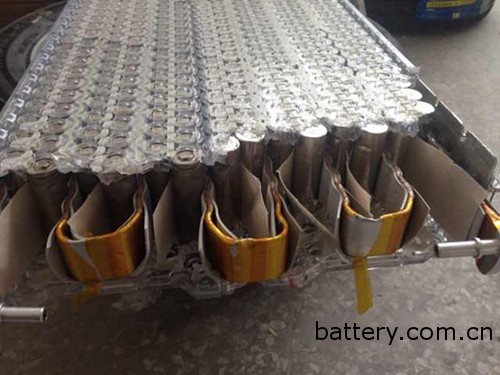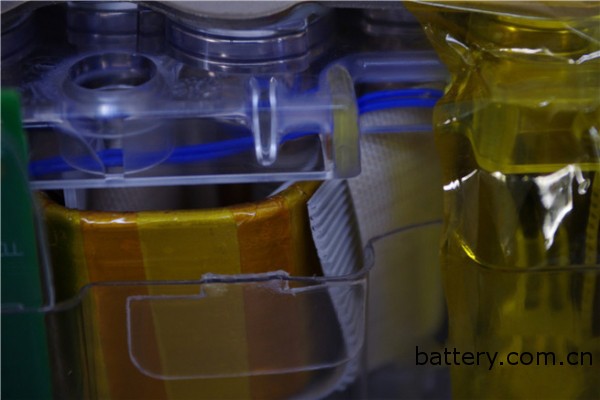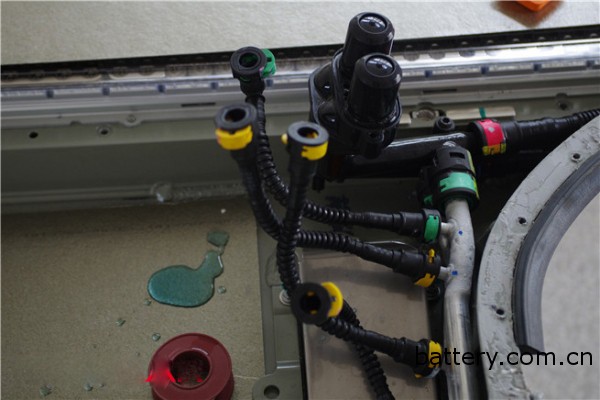In the news released by major media, we learned that Tesla has a special liquid circulation temperature management system around each cell, but its specific structure has never been seen. Some media have said this in the report. According to Tesla's patent description, the water inside the insulation board can be static or flowing. It can be stored directly in the internal cavity of the insulation board or can be loaded into a specific water bag. If it is in a flowing state, it can be connected to the cooling system of the battery pack, or it can be built into the circulation system."
The model of the Ranger car dismantling is the Model S 85, which is not equipped with a cold climate suit. Under the introduction of the engineers, we finally saw the internal structure of the Tesla thermal management system.


(The battery case part in the above picture has been violently dismantled by Ranger Car and some batteries have been removed)
Through violent dismantling, we finally saw the internal structure of the battery pack. Inside the lithium battery pack, a thermally conductive aluminum tube filled with water glycol is surrounded by an S shape. The interface on the left and right sides of the figure is a circulating interface of water glycol liquid, and an orange insulating tape is wrapped around the aluminum tube. In order to prevent accidental rupture of the insulating tape, the aluminum tube is in contact with the lithium battery case to cause a short circuit, and Tesla also adds a layer of insulating glue to the outside of the aluminum tube for isolation. A layer of insulating glue is also used for isolation between other cells that do not have an aluminum tube.
I was very surprised when I first saw Tesla's battery doing so many layers of insulation isolation. After thinking about it, I realized that the 18650 lithium battery used by Tesla is customized. Unlike the lithium battery we usually see, it has an insulating outer coat. The exposed battery case is the negative battery. Once the outer casing is connected by the conductor, It may cause a short circuit, and even a fire accident may occur in serious cases, and the consequences will be unimaginable.
Therefore, Tesla's multi-layer insulation protection inside the battery pack is still very necessary. From the current design structure, Tesla's protection measures are trustworthy.

(Unremoved lithium battery pack details)
Will not flow "coolant"?
After dismantling Tesla, the Knights of the Ranger car told me a very surprising news that the "coolant" in the Tesla cooling aluminum tube will not flow!
When I heard the news, the first reaction was shocking. Tesla took such a big twist to get the aluminum tube in the middle of the battery, but only wrapped the battery, and the "coolant" would not flow? Is this the world's most advanced automotive lithium battery thermal management solution?
With shock and doubt, I carefully examined every part of the heat-dissipating aluminum tube. Unfortunately, I did not find any pump-like and temperature-controlled devices. The "coolant" of Tesla batteries does not actively flow.
I am shocked by the current state-of-the-art thermal management solution for lithium-ion batteries in the world. But since Tesla did this, it must have his reason.

(Lithium battery working liquid interface)
What is the use of water glycol "coolant" wrapped around the battery?
With questions, I checked some relevant information and exchanged ideas with the friends of Ranger. We conclude that the "coolant" is used to maintain the temperature uniformity of the battery. Due to the dense placement of the Tesla battery, the heat accumulated in the central area is bound to be much higher than that in the surrounding area. If there is no aluminum tube to transfer heat to maintain the consistency of the battery temperature, the temperature between the individual cells will be unbalanced. It will affect the consistency of battery performance and the accuracy of battery state of charge (SOC) estimation, thus affecting the system control of electric vehicles.
Although Tesla uses a lithium battery with a very high battery consistency of 18650 lithium cobaltate. For this kind of battery room even joked that "you bought the same batch of 18650 lithium battery, if the instrument detects the inconsistent battery performance, you must first wonder if your instrument has a problem?"
But even if Tesla uses a battery with such a high consistency, there is no guarantee that the battery will be consistent in its actual work. Because the heat rate of the battery at different temperatures (the amount of heat consumed per 1 kW·h of electrical energy) is different, the internal chemical reaction of the battery is closely related to the temperature. If the battery is operated in an internal environment where heat transfer is insufficient, such as heat insulation or high temperature, the battery temperature will rise significantly, resulting in a "hot spot" inside the battery pack, which may eventually cause thermal runaway.
Once the battery consistency occurs, it will have a big impact on the life of the entire battery pack. Therefore, Tesla uses a high heat transfer efficiency aluminum tube and a high specific heat capacity liquid cooling solution to maintain the consistency of the battery temperature, which is not only for safety, but also vital to the life of the electric vehicle.
The battery thermal management system used by Tesla is said to control the temperature difference of each cell in a battery pack to within ±2 °C. In a June 2013 report, Tesla Roadster's battery capacity remained at 80%-85% of its initial capacity after 100,000 miles, and battery capacity degradation was only significantly related to mileage. The relationship with ambient temperature and age is not obvious. It can be seen that Tesla has good control of battery attenuation and is inseparable from the strong support of the battery thermal management system.

(Lithium battery pack working fluid interface and working fluid infusion interface)
According to relevant information, the working liquid formulation in the Tesla aluminum tube is composed of 50% water and 50% ethylene glycol. This is to avoid the occurrence of freezing of the working liquid in a low temperature environment. The green liquid flowing out of the pipe in the above picture is the working liquid of Tesla.
Will Tesla's "coolant" flow?
It is stated in the Tesla patent that "the water inside the separator can be either static or flowing".
Although the patent was submitted long ago, there are still some places to think about the battery working fluid (coolant) cycle. The Model S we saw uses a passive temperature management system with simpler facilities and lower relative costs. Does Tesla also have an active temperature management system? Although this will add some power components, but the working fluid in the car will flow, the overall thermal management system will be more effective.
In this regard, Ranger's small partners have put forward new speculations. If the cold climate kit is purchased, will the temperature management module use active ones?
We suspect that using an active temperature management system, a pump and working fluid heating device can be added to the existing battery temperature control module to ensure a fragile lithium battery to ensure a good operating temperature in extremely cold environments.
But whether this is the case or not, we don't know, and we are looking forward to having God dismantle Tesla with a cold kit again, revealing Tesla's battery insulation system in extremely cold conditions. If the official is willing to announce its internal structure to us, we are also very willing to report it in depth.
"Gravity Die Casting. A permanent mould casting process, where the molten metal is poured from a vessle of ladle into the mould, and cavity fills with no force other than gravity, in a similar manner to the production of sand castings, although filling cn be controlled by tilting the die."
Gravity Die Casting
Sometimes referred to as Permanent Mould, GDC is a repeatable casting process used for non-ferrous alloy parts, typically aluminium, Zinc and Copper Base alloys.
The process differs from HPDC in that Gravity- rather than high pressure- is used to fill the mould with the liquid alloy.
GDC is suited to medium to high volumes products and typically parts are of a heavier sections than HPDC, but thinner sections than sand casting.
There are three key stages in the process.
- The heated mould [Die or Tool] is coated with a die release agent. The release agent spray also has a secondary function in that it aids cooling of the mould face after the previous part has been removed from the die.
- Molten metal is poured into channels in the tool to allow the material to fill all the extremities of the mould cavity. The metal is either hand poured using steel ladles or dosed using mechanical methods. Typically, there is a mould [down sprue" that allows the alloy to enter the mould cavity from the lower part of the die, reducing the formation of turbulence and subsequent porosity and inclusions in the finished part.
- Once the part has cooled sufficiently, the die is opened, either manually or utilising mechanical methods.
Advantages
- Good dimensional accuracy
- Smoother cast surface finish than sand casting
- Improved mechanical properties compared to sand casting
- Thinner walls can be cast compared to sand casting
- Reverse draft internal pockets and forms can be cast in using preformed sand core inserts
- Steel pins and inserts can be cast in to the part
- Faster production times compared to other processes.
- Once the tolling is proven, the product quality is very repeatable.
- Outsourced Tooling setup costs can be lower than sand casting.
Gravity Casting Parts,Aluminum Alloy Gravity Casting Parts,Aluminum Gravity Die Casting Parts,Gravity Casting Aluminum Parts
HSI INDUSTRIEL LTD , http://www.hsiindustriel.com
